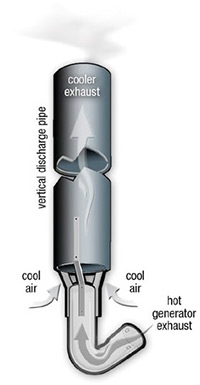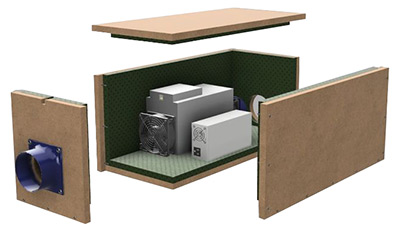Generators are important for many situations. They can be used to power your house during a blackout or run your RV essentials during a camping weekend. However, a loud generator is hard to ignore, and the constant noise can be really irritating. That’s why it’s necessary to know how to reduce generator noise. To do that, it’s essential to understand how noise can spread and how you can control it.
In this guide, we will explain eight simple strategies for reducing generator noise. Each of these steps will reduce noise in a different way. So, let’s get started!
How to Reduce Generator Noise in 8 Steps
There are several things that you can do to reduce noise coming from a generator. Each step will lead to some generator noise reduction in a different way. However, you must note that none of the following steps should interfere with the airflow of the generator. There should be enough air for the generator to avoid overheating and enough room to expel the air from the exhaust.
1. Maximize the Distance
The simplest way to reduce portable generator noise is to increase the distance between the generator and your house or campsite. This may seem like an obvious solution for noise reduction. The idea behind it is that the sound waves will have more ground to cover and, therefore, it will not be as intense. Investing in a long extension cord rated for outdoor use and positioning the generator further away may be enough to solve the noise issue.
The general rule for outdoor open spaces is that when you double the distance from the noise source, you should get a 6-decibel noise reduction. That said, a long extension cord will cause some drop in the voltage. For example, the voltage will drop by 2 to 3 volts for every 32-feet cable increase. Therefore, using a very long extension cable is not advisable.
Note that the generator should not be close to any nearby neighbors so as not to disturb them. While doing that, ensure that you place the generator safely on a dry and stable surface to prevent any damage. Not to mention, you should never connect the generator extensions directly to your electric panel. Instead, you will need to install a transfer switch to safely transfer electricity from your home generator.

2. Proper Positioning
Whether you decide to set your generator near or far from your activity area, one thing you must do is to ensure that you position the generator properly. After all, where you place your portable generator can determine how noisy it will be.
It is advisable to put your portable generator on a flat and level surface. This will prevent your generator from making more noise and vibration sounds than is necessary. You can use the leveling feet to stabilize the generator to the desired position. But keep in mind that the exhaust is the loudest part of any generator. So, positioning the exhaust to point away from your house, neighbors, or occupied areas will significantly reduce the sound intensity.
Apart from being level, the surface you place your generator on should be capable of dampening noise. Instead of concrete or wood, go for dirt, grass, or special anti-vibration mats that are made of rubber or other noise dampening materials. In general, hard surfaces are safer, while softer surfaces are quieter.
3. Use Sound Deflectors
After moving your generator away from your camping or tailgating area, the following method you can use to make your generator quiet as a cricket is to use sound deflectors. Noise deflectors will allow the sound to bounce off right from the source. While this method will not make the motor itself quieter, it’ll reduce the noise significantly.
To do this, you will need four sheets of plywood and a sheet of non-flammable material such as drywall. Each sheet should be around 3 feet tall and 4 feet wide. Then, prop the plywood sheets up against the generator sides at specific angles and use the fire-resistant piece by the side of the exhaust. Drywall is made of pressed gypsum between two sheets of thick paper, so it is relatively non-flammable. As a result, your DIY sound deflectors should not catch fire from the excessive heat coming from the generator’s exhaust.
This method leaves enough room for the generator’s airflow while diverting the sound waves down into the earth. It will allow you to quiet a generator noise without negatively affecting the performance. It is also super easy, and you can use this method when you are traveling and depending on your travel trailer generator.

4. Upgrade the Mufflers
The job of a generator muffler or silencer is to reduce noise coming from the exhaust pipes. Adding a portable generator muffler can reduce the noise coming from your generator by 10 decibels. So it may be worth it to upgrade to a better muffler extension.
There are different types of quiet mufflers for different kinds of generators. One of the reasons for this is because the manufacturers are different. Therefore, getting a muffler that fits out of the box may not be an option. You may have to obtain a technician to help you find a suitable muffler silencer.
Alternatively, you can try a DIY generator exhaust extension if you are a pro in handling mechanical stuff. You can also try to install a car or a motorcycle muffler which will help you quiet a generator noise by yourself. To do this, you will also need to make a custom pipe system to attach it to the generator’s exhaust.
5. Move the Exhaust Pipe Vertically
Generally, the extension exhaust pipes of generators point horizontally, making the sound waves move in one direction. The exhaust pipe may also be pointed directly towards your neighbors or the area of your activity, which can make the sound waves travel directly towards you.
However, if you adjust the muffler extension to point vertically towards the sky, you will allow the sound waves to be directed towards up rather than towards your activity areas. As a result, this will give some improvement and act as a sound barrier method.

6. Build a Soundproof Enclosure Box
One of the most effective ways of reducing generator noise is by building a soundproofing box. Using a soundproof enclosure will allow for acoustic shielding against a noisy generator. There are ready portable generator enclosures on the market that you can buy, such as the baffle box or zombie box. Alternatively, you can also make your DIY generator enclosure as a noise reduction method for your standby generator or portable generator.
Using a generator soundproof box will help in absorbing and deflecting the noise. However, you don’t simply place the generator in an enclosed shed. You should make sure that the generator has enough air to burn, gets enough air to keep cool, and can freely get rid of its exhaust air. The exhaust will require adequate ventilation, and the airflow is vital to prevent the generator from overheating. As a result, the generator enclosure design should be spacious enough for your generator model.
Additionally, it should have an easy accessing method to perform maintenance on your generator when needed. And remember that generators produce carbon monoxide, which is dangerous and can lead to CO poisoning. So placing them in the garage or a shed that you use is not an option.
A generator enclosure is typically made from sheet metal or powder-coated aluminum to prevent rust or corrosion. You can use rubber gaskets at the edges and joints that provide a seal against the noise. You can also use concrete blocks or treated lumber as an alternative. Checking different generator box designs may be necessary before finding one that is easy for you to make. Ultimately, with a generator enclosure, you can reduce the noise level by up to 10 decibels.
7. Enclosure Noise Insulation
If a generator box alone doesn’t do the trick, insulation can further cut down on the noise level and create an additional soundproofing barrier. There are different materials that you can use to insulate the generator box. For example, sound-absorbing foam, rubber waffle pads, and dampers.
You can install these soundproof mounts on the inner walls of the generator box. You can also place the generator on top of a rubber mat or other sound-deadening materials to isolate the vibration, which in turn will dampen the noise.
8. Final Option
If all the above steps didn’t reduce the noise to a minimal level, consider upgrading to one of these quieter generators. Some models are just quieter than others. This can come down to a better engine with minimal vibrations, a better housing shell, and a good muffler. One of such generators is the Honda EU2200i. Honda is famous for its high-performing generators.
Other examples of such brands are Champion Power Equipment, WEN, Westinghouse, Briggs and Stratton, and Generac, specifically their inverter generator models. Already, the inverter models usually provide less noise compared to conventional generators. However, for the ultimate noiseless and fume-free electricity, you can go for a portable power station.
FAQ
Generally, noise levels are measured in decibels (dB). This measurement may differ based on the type and size of the engine. Usually, a loud generator will range between 70 to 90 decibels and even go beyond 100 decibels. The industry-standard measurement is taken from 23 feet away. For most generators, the measurement is listed in the specification sheet.
Apart from the generator type and engine size, the major part where the noise comes from is the exhaust. The exhaust acts as a propeller that moves and causes air resistance. Another thing that can contribute to the noise is the cooling fan. The sounds generated by the cooling fan may differ based on the design of the fan blade and the speed at which it operates. Moreover, the generator housing design may lack internal sound dampening materials to shield the sound. Not to mention the vibrations of loose nuts, bolts, and unstable feet.
It all depends on your needs or preferences. Using acoustic barriers is the easiest method of all to reduce generator noise. By placing the panels around the generator at different angles, you can get some noise reduction. This method will redirect the sound and prevent it from reaching you. Apart from sound deflectors, a generator box is the most effective. They work like sound barriers, and by insulating them, you can have a significant noise reduction effect. In addition, upgrading to a better muffler is also one such method, but it requires some technical knowledge.
Conclusion
If you want the best solution for reducing generator noise, the easiest option is sound deflectors, while the best option is building a generator box. Both methods are similar as you basically place acoustic panels around the generator to muffle the noise. Aside from reducing noise, they are also weatherproof and can keep your generator safe. Some options you can explore are making an enclosure and insulating it. These two options are the simplest noise reduction solutions. They will help in soundproofing the noise even before it gets to you. As long as you leave enough space for ventilation and airflow, then you are good to go. Because if there’s no proper ventilation, your generator can experience overheating.
At this point, you should be able to choose one or more methods to reduce generator noise. The right choice will depend on your budget and the generator size.

